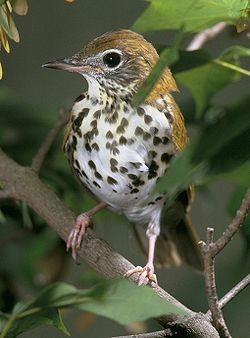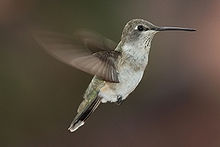
Hi Everybody!!
January is a time for celebrating Life as various things wake up from Winter Pause. Today I saw my first little sulphur butterfly of 2014. I feel joy in seeing the winter hummingbird play in the sun and the woodpecker digging for hidden treats. I am pleased so many of you are beginning an interest in birds. Pop Quiz: Which North American Songbird has the most beautiful song? Of course, the answer is below in the shared excerpt Wikipedia Info. as well as links to the photostudies in my G+ Albums. I encourage all of you to find something new to see everyday outside. Enjoy!

https://en.wikipedia.org/wiki/Wood_Thrush
Wood Thrush
From Wikipedia, the free encyclopedia
The Wood Thrush (Hylocichla mustelina) is a North American passerine bird. It is closely related to other thrushes such as the American Robin and is widely distributed across North America, wintering in Central America and southern Mexico. The Wood Thrush is the official bird of the District of Columbia.[2]
The Wood Thrush is a medium-sized thrush, with brown upper parts with mottled brown and white underparts. The male and female are similar in appearance. Thesong of the male is often cited as being the most beautiful in North America.
The Wood Thrush is an omnivore, and feeds preferentially on soil invertebrates and larvae, but will also eat fruits. In the summer, it feeds on insects continuously in order to meet daily metabolic needs. It is solitary, but sometimes form mixed-species flocks. The Wood Thrush defends a territory that ranges in size from 800 to 28,000 m2 (960 to 33,000 sq yd). The Wood Thrush is monogamous, and its breeding season begins in the spring; about 50% of all mated pairs are able to raise two broods, ranging in size from 2 to 4 chicks.[3]
| Wood Thrush | |
|---|---|
 | |
| Conservation status | |
| Scientific classification | |
| Kingdom: | Animalia |
| Phylum: | Chordata |
| Class: | Aves |
| Order: | Passeriformes |
| Family: | Turdidae |
| Genus: | Hylocichla Baird, 1864 |
| Species: | H. mustelina |
| Binomial name | |
| Hylocichla mustelina (Gmelin, 1789) | |
Distribution and habitat[edit]
The Wood Thrush's breeding range extends from Manitoba, Ontario and Nova Scotia in southern Canada to northern Florida and from the Atlantic coast to the Missouri River and the eastern Great Plains. It migrates to southern Mexico through to Panama in Central America in the winter, mostly in the lowlands along the Atlantic and Pacific coasts.[12] It generally arrives on the U.S. Gulf Coastduring the first week of April. Fall migration usually begins in mid-August and continues through mid-September. Migration takes place at night,[10] allowing them to find their direction from the stars and orient themselves by detecting the Earth's magnetic field.[14]
The Wood Thrush prefers deciduous and mixed forests for breeding. It prefers late-successional, upland mesic forests with a moderately-dense shrub layer. Robert I. Bertin (1977) found that this thrush favors areas with running water, moist ground, and high understorey cover.[10] The breeding habitat generally includes trees taller than 16 m (52 ft), a fairly open forest floor, moist soil, and leaf litter, with substrate moisture more important than either canopy cover or access to running water. The Wood Thrush can breed in habitat patches as small as 0.4 hectares (0.99 acres), but it runs the risk of higher predation and nest parasitism.[10] The Wood Thrush's breeding range has expanded northward, displacing the Veery and Hermit Thrush in some locations. In recent times, as a result of fragmentation of forests, it has been increasingly exposed to nest parasitism by Brown-headed Cowbirds, as well as loss ofhabitat in the winter range.
Vocalizations[edit]
The Wood Thrush has been reported to have one of the most beautiful songs of North American birds.[12] American naturalist Henry David Thoreau wrote:
Whenever a man hears it he is young, and Nature is in her spring; wherever he hears it, it is a new world and a free country, and the gates of Heaven are not shut against him.
While the female is not known to sing, the male has a unique song that has three parts. The first subsong component is often inaudible unless the listener is close, and consists of two to six short, low-pitched notes such as bup, bup, bup. The middle part is a loud phrase often written ee-oh-lay, and the third part is a ventriloquial, trill-like phrase of non-harmonic pairs of notes given rapidly and simultaneously.
The male is able to sing two notes at once, which gives its song an ethereal, flute-like quality.[13] Each individual bird has its own repertoire based on combinations of variations of the three parts. Songs are often repeated in order. The bup, bup, bup phrase is also sometimes used as a call, which is louder and at a greater frequency when the bird is agitated.[3] The Wood Thrush also use a tut, tut to signal agitation.[10] The nocturnal flight call is an emphatic buzzing heeh.[8]

Link to photostudy in G+ Albums:
https://plus.google.com/u/0/photos/117645114459863049265/albums/5971350754608027473

The first little butterfly of 2014 comes out for sun!

Link to photostudy in G+ Albums:
https://plus.google.com/u/0/photos/117645114459863049265/albums/5971344239842623473


Link to photostudy in G+ Albums:
https://plus.google.com/u/0/photos/117645114459863049265/albums/5971351854315881537

I hide seed down in the holes of this petrified wood rock. The pecker seeks these hidden morsels!

https://en.wikipedia.org/wiki/Red-bellied_Woodpecker
| Red-bellied Woodpecker | |
|---|---|
 | |
| Adult male | |
| Conservation status | |
| Scientific classification | |
| Kingdom: | Animalia |
| Phylum: | Chordata |
| Class: | Aves |
| Subclass: | Neornithes |
| Infraclass: | Neognathae |
| Superorder: | Neoaves |
| Order: | Piciformes |
| Suborder: | Pici |
| Family: | Picidae |
| Subfamily: | Picinae |
| Tribe: | Dendropicini |
| Genus: | Melanerpes |
| Species: | M. carolinus |
| Binomial name | |
| Melanerpes carolinus (Linnaeus, 1758) | |
 | |
| Range of M. carolinus | |

He got it!

The Winter Hummingbird: Me and my shadow!

Link to photostudy in G+ Albums:
https://plus.google.com/u/0/photos/117645114459863049265/albums/5970810932148079345

Fun from G+ Auto BackUp:



The Golden Winter Hummingbird:

https://en.wikipedia.org/wiki/Hummingbird
Hummingbird
From Wikipedia, the free encyclopedia
Hummingbirds are birds that constitute the family Trochilidae. They are among the smallest of birds, most species measuring in the 7.5–13 cm (3–5 in) range. Indeed, the smallest extant bird species is a hummingbird, the 5-cm Bee Hummingbird. They hover in mid-air by rapidly flapping their wings 12–80 times per second (depending on the species). They are known as hummingbirds because of the humming sound created by their beating wings, which sometimes sounds like bees or other insects. To conserve energy while they sleep or when food is scarce, they have the ability to go into a hibernation-like state (torpor) where their metabolic rate is slowed to 1/15th of its normal rate.[1] When the nights get colder, their body temperature can drop significantly and thus slow down their heart and breathing rate, thus burning much less energy overnight. As the day heats back up, the hummingbirds' body temperature will come back up and they resume their normal activity.[2] They can fly at speeds exceeding 15 m/s (54 km/h; 34 mph);[3] they are also the only group of birds with the ability to fly backwards.[4] Individuals from some species of hummingbirds weigh less than a penny.
| Hummingbirds | |
|---|---|
 | |
| Female Black-chinned Hummingbird | |
| Scientific classification | |
| Kingdom: | Animalia |
| Phylum: | Chordata |
| Class: | Aves |
| Subclass: | Neornithes |
| Infraclass: | Neognathae |
| (unranked): | Cypselomorphae |
| Order: | Apodiformes |
| Family: | Trochilidae Vigors, 1825 |
Migration[edit]
Most hummingbirds of the U.S. and Canada migrate south in fall to spend the winter in Mexico or Central America. A few southern South American species also move north to the tropics during the southern winter. A few species are year-round residents in the warmer coastal and southern desert regions on the USA. Among these are Anna's Hummingbird, a common resident from California inland to Arizona and north to southwestern coastal British Columbia, and Buff-bellied Hummingbird, an uncommon resident in subtropical woodlands of southern Texas.
The Rufous Hummingbird is one of several species that breed in temperate western North America and are wintering in increasing numbers in the warm subtropical southeastern United States, rather than in tropical Mexico. The Rufous Hummingbird nests farther north than any other species and must tolerate occasional temperatures below freezing on its breeding grounds. This cold hardiness enables it to survive temperatures below freezing, provided that adequate shelter and food are available.
Feeders and artificial nectar[edit]
Hummingbirds will also take sugar-water from bird feeders. Such feeders allow people to observe and enjoy hummingbirds up close while providing the birds with a reliable source of energy, especially when flower blossoms are less abundant.
White granulated sugar is the best sweetener to use in hummingbird feeders. A ratio of 1 part sugar to 4 parts water is a common recipe.[38] Boiling and then cooling this mixture before use has been recommended to help deter the growth of bacteria and yeasts. Powdered sugars contain corn starch as an anti-caking agent; this additive can contribute to premature fermentation of the solution. Brown, turbinado, and "raw" sugars contain iron, which can be deadly to hummingbirds if consumed over long periods.[39] Honey is made by bees from the nectar of flowers, but it is not good to use in feeders because when it is diluted with water, microorganisms easily grow in it, causing it to spoil rapidly.[40][41][42]

Link to photostudy in G+ Albums:
https://plus.google.com/u/0/photos/117645114459863049265/albums/5971398219524431953


...this is brendasue signing off from Rainbow Creek. See You next time!

O+O



No comments:
Post a Comment
Hi Everybody! Please say hello and follow so I know you are here! Due to the inconsideration of people trying to put commercials on my blog comment area, I have restricted use of anonymous posts. Sorry that some hurt all.
My public email is katescabin@gmail.com No spammers or trolls